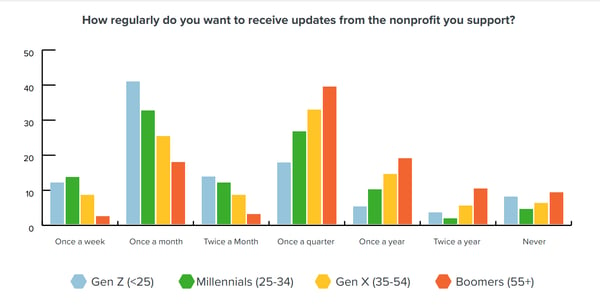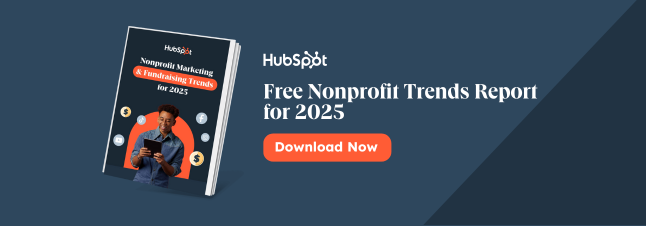However, marketing — especially for nonprofits — couldn’t be more vital for the betterment of your beneficiaries. By raising awareness and engagement, nonprofits can achieve their goals and make a real difference in the world.
Use these nonprofit marketing statistics to inform your marketing strategy and maximize your budget in 2023 and beyond.
Table of Contents
- Why Marketing Matters for Nonprofits
- Nonprofit Marketing Trends
- Which Nonprofit Marketing Channels Generate Results
- Nonprofit Social Media Statistics
Why Marketing Matters for Nonprofit
Nonprofits that invest in marketing can have more of an impact. They’re able to get their nonprofit organization in front of more people.
“Nonprofits have to use marketing tools and tactics to tell their stories, spread their impacts, and garner support from the greater community,” says Joshua Fields, co-founder of the nonprofit The Next Step Programs.
"The more connected we are with the community, the more families we reach, the more services we provide, and the more resources we can generate.”
Setting aside a budget for marketing can increase the impact of your message, the money your raise, and the number of volunteers you have. Other benefits include:
- Raising awareness for your mission.
- Attracting new donors and supporters.
- Building relationships with current donors and encouraging donor retention.
To effectively build your strategy, you’ll need to understand the landscape of nonprofit marketing. We’ll explore essential trends in the next section.
Nonprofit Marketing Statistics
The State of Philanthropy
- In 2021, giving grew by 4%, even with challenging economic conditions.
- Memberships still matter. Cultural nonprofits generated 53% of their online revenue from memberships, while Public Media generated 100% from memberships.
- 45% of donors are donating to crowdfunding campaigns that benefit nonprofits.
- 56% also donate through online stores that benefit NPOs. Consider creating an online store for your nonprofit if you don’t already have one.
- NFTs are taking off as a way to raise money for your nonprofit. Unsilenced Voices sets up NFT art competitions for the girls in their program to draw/paint pictures. The nonprofit mints and sells them to fund school tuition, supplies, and lunch for the girls.
- Nonprofits raised $78 for every 1,000 fundraising messages sent.
- Partnerships, social media challenges, and user-generated content remain some of the most effective ways to gain funds. Use your social media channels to amplify people already supporting your organization.

Which Nonprofit Marketing Channels Generate Results
- Most donors are more inspired to give when email marketing or social media is the communication medium (26% and 25% respectively). Meanwhile, other media generate 12% of donations.
- On average, nonprofits increased digital advertising budgets by 19% in 2021 to reach new and existing audiences.
- Nonprofit email list growth is on the rise. Email list sizes increased by 7% in 2021, compared with 4% and 2% in the previous two years.
- If you haven’t already, dive into events. Events with peer-to-peer fundraising converted at 47%. This is the highest rate of all campaign types, according to research from Classy.
- Nonprofits invested 19% more in digital advertising in 2021 compared to 2020.
- Search ads (Google ads for example) deliver the biggest return on ad spend ($3.72) while display and social media generated $0.59 and $0.57, respectively.
- The average cost per click sits at $2.99 for social media ads, up to $3.68 for video, and $3.72 for search advertising.

Nonprofits Social Media Statistics
- Donors between the ages of 18 and 29 increased the amount they donated during the COVID-19 pandemic. Of these donors, one in four wants social media communication from nonprofits.
- 48% of social media platform donors give on Facebook. That’s double the impact of Instagram (24%), and other platforms at less than 10% each.
- Mobile apps, Facebook, social media, and text messages are the most popular ways for Gen Z and Gen X to donate.
- Donors like to give through social media fundraising tools too. 32% have donated through Facebook Fundraising Tools and 89% of those say they’ll do it again.
- Pay attention to TikTok. The platform directly contributed $7 million in donations to nonprofits using the app.
- Social media and constant communication won’t work for every age group. Boomers and Gen Xers prefer quarterly or yearly communication to monthly or weekly.

How Users Want to Make Donations
- Users on desktop devices donate 76% of total revenue and perform 65% of total transactions.
- 55% prefer to donate online using their credit or debit cards — a cue that digital marketing is important.
- Make sure you have multiple ways to donate on your website. The average one-time donation was nearly 1.5x more when nonprofits offered ACH, PayPal, and digital wallet payments.
- HubSpot found that Gen Z prefers to donate via Facebook, social media, texting, or mobile apps.
- Meanwhile, millennials prefer texting or app-based donations.
- The number one reason Gen X may choose not to donate to an org is an outdated website.
Making the Most of Your Strategy
One thing remains constant with these stats: Data-based decisions are more important than ever.
Invest in a nonprofit technology that tracks and provides visibility for all your data. Be sure to stay up-to-date with the nonprofit marketing world and trends shift.
Nonprofit Marketing





.png)







